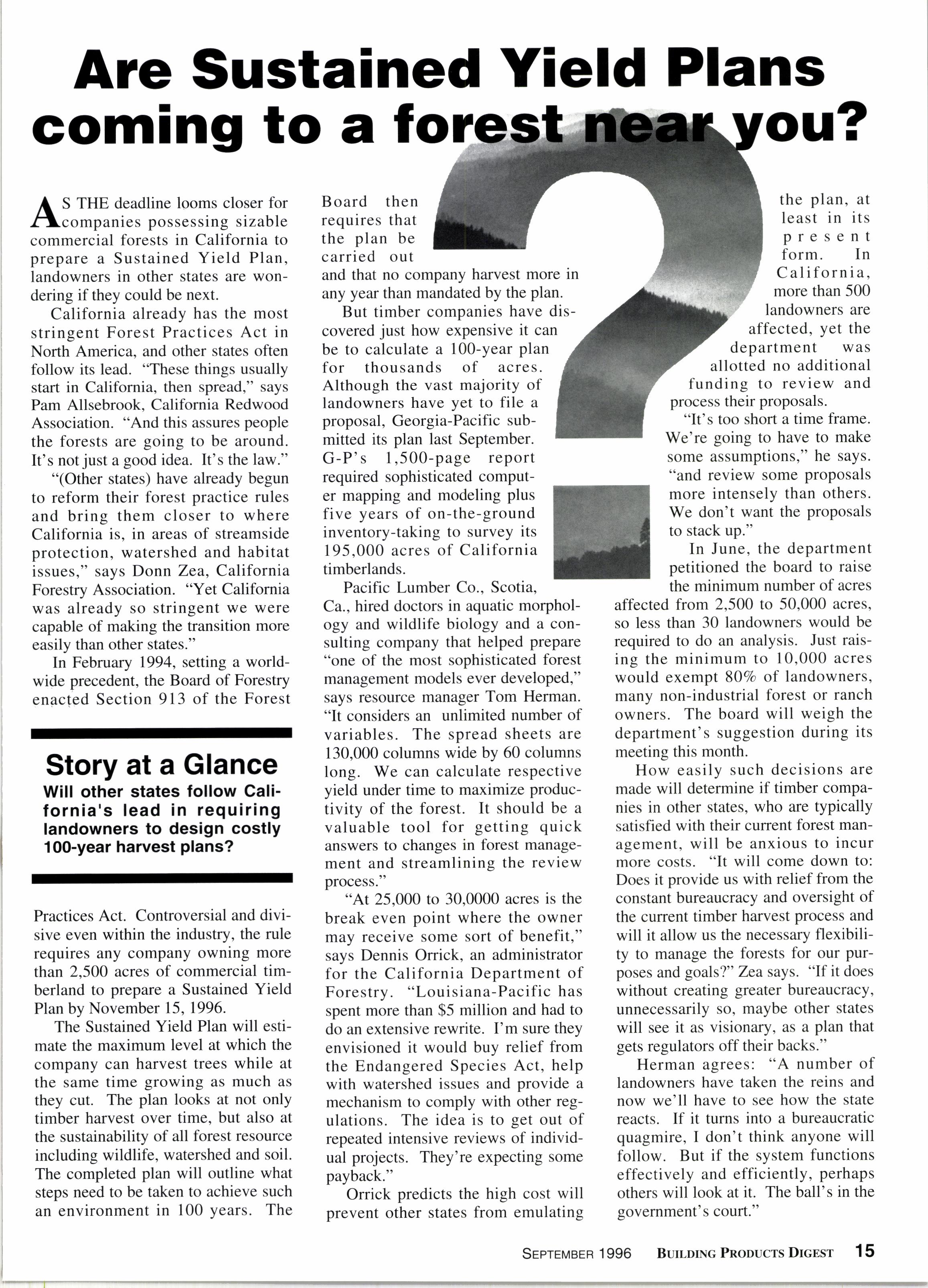
3 minute read
coming to a fo Are Sustained Yield Plans ou?
A S THE deadline looms closer for la.companies possessing sizable commercial forests in California to prepare a Sustained Yield Plan, landowners in other states are wondering ifthey could be next.
California already has the most stringent Forest Practices Act in North America, and other states often follow its lead. "These things usually start in California, then spread," says Pam Allsebrook, California Redwood Association. "And this assures people the forests are going to be around. It's not just a good idea. It's the law."
"(Other states) have already begun to reform their forest practice rules and bring them closer to where California is, in areas of streamside protection, watershed and habitat issues," says Donn Zea, California Forestry Association. "Yet California was already so stringent we were capable of making the transition more easily than other states."
In February 1994, setting a worldwide precedent, the Board of Forestry enacted Section 913 of the Forest
Story at a Glance
Will other states follow California's lead in requiring landowners to design costly 1O0-year harvest plans?
Practices Act. Controversial and divisive even within the industry, the rule requires any company owning more than 2,500 acres of commercial timberland to prepare a Sustained Yield Plan by November 15,1996.
The Sustained Yield Plan will estimate the maximum level at which the company can harvest trees while at the same time growing as much as they cut. The plan looks at not only timber harvest over time, but also at the sustainability of all forest resource including wildlife, watershed and soil. The completed plan will outline what steps need to be taken to achieve such an environment in 100 vears. The
Board then requires that the plan be carried out and that no company harvest more in any year than mandated by the plan.
But timber companies have discovered just how expensive it can be to calculate a 100-year plan for thousands of acres. Although the vast majority of landowners have yet to file a proposal, Georgia-Pacific submitted its plan last September. G-P's 1,5OO-page report required sophisticated computer mapping and modeling plus five years of on-the-ground inventory-taking to survey its 195,000 acres of California timberlands.
Pacific Lumber Co., Scotia, Ca., hired doctors in aquatic morphology and wildlife biology and a consulting company that helped prepare "one of the most sophisticated forest management models ever developed," says resource manager Tom Herman. "It considers an unlimited number of variables. The spread sheets are 130,000 columns wide by 60 columns long. We can calculate respective yield under time to maximize productivity of the forest. It should be a valuable tool for getting quick answers to changes in forest management and streamlining the review process."
"At 25.000 to 30.0000 acres is the break even point where the owner may receive some sort of benefit," says Dennis Orrick, an administrator for the California Department of Forestry. "Louisiana-Pacific has spent more than $5 million and had to do an extensive rewrite. I'm sure they envisioned it would buy relief from the Endangered Species Act, help with watershed issues and provide a mechanism to comply with other regulations. The idea is to get out of repeated intensive reviews of individual projects. They're expecting some payback."
Orrick predicts the high cost will prevent other states from emulating the plan, at least in its present form. In California, more than 500 landowners are affected, yet the department was allotted no additional funding to review and process their proposals.
"It's too short a time frame. We're going to have to make some assumptions," he says. "and review some proposals more intensely than others. We don't want the proposals to stack up."
In June, the department petitioned the board to raise the minimum number of acres affected from 2,500 to 50,000 acres, so less than 30 landowners would be required to do an analysis. Just raising the minimum to 10,000 acres would exempt SOVo of landowners, many non-industrial forest or ranch owners. The board will weigh the department's suggestion during its meeting this month.
How easily such decisions are made will determine if timber companies in other states, who are typically satisfied with their current forest management, will be anxious to incur more costs. "It will come down to: Does it provide us with relief from the constant bureaucracy and oversight of the current timber harvest process and will it allow us the necessary flexibility to manage the forests for our purposes and goals?" Zea says. "If it does without creating greater bureaucracy, unnecessarily so, maybe other states will see it as visionary, as a plan that gets regulators off their backs."
Herman agrees: "A number of landowners have taken the reins and now we'll have to see how the state reacts. If it turns into a bureaucratic quagmire, I don't think anyone will follow. But if the system functions effectively and efficiently, perhaps others will look at it. The ball's in the government's court."
Anniversaries: Forest History Society, Durham, N.C., 50th Independent Lumber Co., Adair, Ok.,50th...










